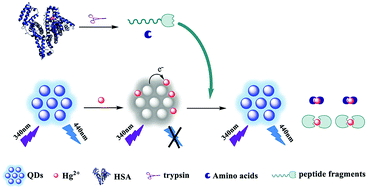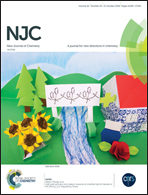A novel fluorescence strategy for mercury ion and trypsin activity assay based on nitrogen-doped graphene quantum dots†
Abstract
In this paper, we developed a simple, convenient and sensitive fluorescent probe for mercury ions (Hg2+) and trypsin activity assay based on nitrogen-doped graphene quantum dots (N-GQDs). Hg2+ can quench the fluorescence of N-GQDs due to electron transfer from N-GQDs to Hg2+. However, amino acids or peptide fragments formed by hydrolysis of human serum albumin (HSA) in the presence of trypsin have a stronger affinity for Hg2+, thus the fluorescence of N-GQDs will be recovered after the addition of HSA and trypsin. Hg2+ and trypsin activity could be monitored via the change of fluorescence intensity of the N-GQDs. Under optimal conditions, the fluorescence intensity of N-GQDs was proportional to the concentration of Hg2+ and trypsin in the range of 0.02–1 μM and 0.03–8 μg mL−1 with a limit of 0.0047 μM and 0.0063 μg mL−1, respectively. Besides, soybean trypsin inhibitor (SBTI) as a model for trypsin inhibition was used to confirm the feasibility of the system and the value of IC50 is 1.31 μg mL−1. The proposed method was successfully applied to the determination of Hg2+ and trypsin activity in real samples with satisfactory results.



 Please wait while we load your content...
Please wait while we load your content...